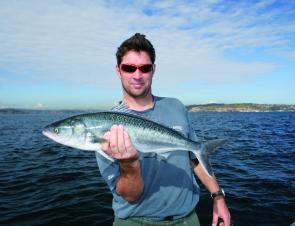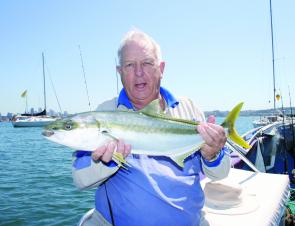This is the prime time of year for surface-feeding pelagics so now is probably a good time to kick your lure collection into action.
As I write, salmon are swarming at the Heads, kings are making an early run into the Harbour and with Middle Harbour full of baitfish, it’s looking like a great season ahead.
It’s also a good time to take a shot at bream and flatties on artificials. Before I get into what lures to use on what fish, I'll go over a few tips on making sure that your lure kit is up to scratch.
The most important part of your lures are the hooks. Inspect them for rust, which can make your hooks weak and blunt. A rusty hook will not penetrate as smoothly as a shiny one. Replace rusty hooks and split rings.
You might decide to replace your hooks with chemically sharpened ones which will improve your hook-up rate. If you decide to go with standard hooks then take to them with a sharpening stone and get those points razor-sharp.
Check that your lures are performing correctly. The style of lures that are most likely to get out of tune are the hard-bodied minnows. A bump on the bib last season can put them out of tune, which will make them swim off to one side. In really bad cases they might even spin.
Adjustment can be made by bending the tow eyelet a fraction in the opposite direction to which the lure is swimming. With some lures, like the Rapala CD series for example, it’s nearly impossible to bend the eyelet due to its solid construction. In this case you can make the same adjustments by bending the bib itself.
Naturally this is only practical with the metal-bibbed lures and should not be attempted with the plastic bibs.
Other maintenance might include cleaning dirty painted finishes, polishing tarnished metal reflective surfaces and patching up torn soft plastics with a hot wire.
Organisation of your lures in your tackle box is equally as important. There's nothing more frustrating than reaching for a suitable lure while tuna are busting out all around your boat and finding that it comes out in a tangled mess with 20 others. The time taken sorting out the mess can often exceed a feeding spree.
Plastic hook guards are a great remedy for this but remember to keep the WD40 up to them because they have a tendency to hold moisture.
Sort your lures into types and sizes and familiarise yourself with their positions in the box.
Kingies are one of the tougher lure opponents found in Sydney Harbour. They’re tough in that they don't respond very well to most of what we throw at them and tough when one is finally hooked – they fight hard and dirty. Not that they are not taken on minnows, but in general, they are largely ignored.
When kings are schooling and feeding on the surface they will grudgingly take metal slugs. They show quite a bit more interest in surface poppers. The best lures, by a long stretch, are the soft plastic stickbaits.
The original Slug-Go and its imitators like Platinum lures are still by far the best design for pelagic work.
Keep an eye out for the new Kingi Kruncha from Bozos Lures. They are primarily a Slug-Go rip-off but with tougher plastic, prism reflector tape finish, garlic scent and a reliable supply means they should blitz the pelagic stickbait market.
When I took delivery of some prototypes I was worried that the extra hardness of the plastic might affect the action but it didn't at all and I got many more casts/fish out of them, compared with other brands, before they were damaged beyond use.
Salmon can be the most or least fussy of lure-takers. There are plenty of times when they will eat any reasonable offering thrown at them
Trolled minnows are a good way of finding salmon when they are not feeding on the surface. When they are on top, casting small poppers or metal slices is the way to go. When they get fussy, only the tiniest lures will tempt them.
Tailor and bonito are very reliable lure-chompers but they are either there or they’re not. If they are about, they will usually bite and they aren't very fussy about lure size or type. Just because tailor are feeding on tiny baitfish doesn't mean they will take only tiny lures.
Trolling minnows is a good way to find them if you can't see them on the surface. If they are chomping on top then you can throw almost anything at them, with a preference for metal slugs or spoons.
Mackerel tuna and frigate mackerel are very similar in the way that they hunt and in their food preferences. Very small metal slugs are the order of the day. Occasionally macs will take a trolled minnow but in the Sydney region it’s a rare occurrence.
All of the abovementioned species respond very well to flies, which are among of the most deceptive lures we can present. It must be remembered, though, that because of the means of delivery, fly fishing is relatively inefficient. On the other side of the coin, it is a great test of an anglers skill and a lot of fun.
Reads: 1394
Just because tailor are feeding on tiny baitfish doesn't mean they will take only tiny lures.

Salmon can be the most or least fussy of lure-takers. There are plenty of times when they will eat any reasonable offering thrown at them.

Kings can be tough to tempt and are notorious lure collectors once hooked. Make sure your hardware is up to the task.




